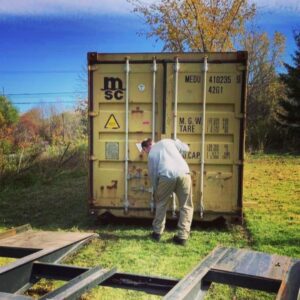40ft Standard Container: The Essential Guide
When it comes to international shipping and logistics, one of the unsung heroes of the industry is the 40ft standard container. These unassuming metal boxes might not grab headlines, but they play a pivotal role in global trade, ensuring goods make their way from one corner of the world to another. In this article, we’ll uncover the secrets of this cargo giant, exploring its history, dimensions, uses, weight, and capacity while also addressing key considerations like container purchase, transportation, and storage.
Expanding on this, 40ft containers are not only crucial in logistics but also in various industries. They serve as essential components in modular architecture, pop-up retail spaces, emergency housing solutions, and even in green energy projects. The adaptability of these containers allows them to be repurposed into sustainable living spaces, mobile hospitals, and even data centers, showcasing their incredible utility beyond just shipping and storage.

Understanding Container Basics
What is a 40ft Standard Container?
The 40ft standard container, often referred to as the 40-foot shipping container, is a standardized steel box designed for transporting goods across the globe. Due to its uniform size, durability, and cost-efficiency, it has become a cornerstone of the shipping industry.
40ft Container Dimensions and Capacity
A 40-foot container typically has the following dimensions:
- Exterior Dimensions: 40 feet long, 8 feet wide, and 8.5 feet high
- Interior Dimensions: 39.5 feet long, 7.8 feet wide, and 7.9 feet high
- Storage Capacity: 2,390 to 2,700 cubic feet
- Maximum Gross Weight: 67,200 lbs (30,480 kg)
- Tare Weight: Approximately 8,000 lbs (3,630 kg)
- Payload Capacity: 59,200 lbs (26,850 kg)
A 40ft high cube container provides an extra foot of height, making it ideal for transporting taller cargo.
A Brief History of Containerization
Containerization revolutionized the shipping industry, bringing about a transformative shift in how goods are moved worldwide.
The Birth of Containerization
In the 1950s, Malcolm McLean, a trucking entrepreneur, introduced containerization, revolutionizing the shipping industry. His innovation reduced the need for manual loading and unloading, cutting costs and increasing efficiency.
Impact on Global Trade
Before containerization, ocean freight relied on labor-intensive loading methods. The introduction of standardized containers transformed global trade by enabling seamless transportation between ships, trucks, and trains.

The Many Uses of 40ft Containers
The versatility of 40ft containers extends far beyond just cargo shipping. They serve a multitude of purposes, making them invaluable in various industries.
Cargo Shipping
The 40ft shipping container is primarily used for transporting goods, ensuring safe and efficient delivery of electronics, textiles, machinery, and more.
Storage Solutions
Businesses and individuals use shipping containers for container storage, creating secure and weather-resistant warehouses for tools, equipment, and inventory.
Mobile Offices and Workspaces
Creative entrepreneurs repurpose 40ft containers into mobile offices, cafes, and tiny homes, leveraging their versatility and durability.
Beyond these common uses, 40ft containers are also being utilized in creative and industrial applications. They serve as foundations for modular construction projects, providing affordable and sustainable housing solutions. Additionally, many companies are converting them into pop-up shops, mobile event spaces, and even urban farms. In disaster relief efforts, these containers are transformed into temporary medical centers and emergency shelters. Their structural integrity makes them ideal for underground bunkers and secure data storage facilities as well. The adaptability of 40ft containers continues to expand, making them a crucial component in modern infrastructure and innovation.
Weight and Load Considerations
How Much Does a 40ft Shipping Container Weigh?
The 40ft container weight varies depending on the type and material. The standard tare weight is approximately 8,000 lbs (3,630 kg), while its maximum gross weight can reach 67,200 lbs (30,480 kg).
How Much Does a 20ft Shipping Container Weigh?
A 20 ft container weight is typically around 4,800 lbs (2,177 kg), with a maximum payload capacity of about 55,000 lbs (24,947 kg).

Why 40ft Standard Containers Rule the Shipping World
Several factors contribute to the dominance of 40ft standard containers in the shipping industry.
Cost-Efficiency
A 40′ shipping container for sale is an affordable investment, offering long-term durability and multi-purpose functionality.
Durability & Strength
Constructed from corrosion-resistant steel, these containers withstand harsh weather and heavy loads, ensuring long-term reliability.
Stackability & Transportation
The standardized 40ft container dimensions allow efficient stacking on cargo ships, optimizing container transportation and logistics.
Common Container Types and Their Uses
- Standard 40′ shipping container dimensions – Ideal for general cargo.
- High Cube Container – Extra height for bulkier shipments.
- 40-foot new, tunnel container –
- 40′ Single-Entry Container – Secure, limited-access design.
- Refrigerated Containers – Used for temperature-sensitive goods.
The Environmental Angle
Sustainability in Shipping
Recycling and repurposing shipping containers reduce waste and promote eco-friendly construction solutions. These containers can be transformed into sustainable housing, mobile offices, or even emergency shelters, significantly reducing the demand for new construction materials. Additionally, using recycled shipping containers for modular projects helps lower carbon footprints and supports innovative, cost-effective architecture. Many businesses are now investing in refurbished containers for storage, retail spaces, and even vertical farming, further proving their environmental and functional advantages.
Challenges and Solutions
Despite their many advantages, 40ft containers also face challenges in certain situations.
Weight Restrictions
Cargo weight limits vary by region, necessitating proper container loading practices.
Size Constraints
Understanding how wide is a 40-foot shipping container is crucial for planning transportation routes and delivery logistics.
Conclusion
The 40ft standard container is an essential element of global trade, offering unmatched versatility, durability, and efficiency. Whether for shipping, storage, or repurposing, these containers remain a cornerstone of the shipping industry. Their standardized dimensions ensure easy handling across various transportation modes, while their robust steel construction makes them resilient to harsh weather conditions. Furthermore, these containers contribute significantly to sustainability efforts as they are often repurposed into housing, mobile workspaces, and eco-friendly architectural projects. The continued innovation around 40ft containers ensures that they will remain indispensable in global logistics and infrastructure development.
FAQs
Are 40ft containers the largest available?
No, they’re not. There are larger containers, such as the 45ft and 53ft varieties, but the 40ft standard container is the most widely used due to its balance of size and versatility.
Can I buy a 40ft container for personal use?
Yes, you can purchase a 40ft container for personal use, be it for storage, conversion into a workspace, or even as a tiny home.
How much weight can a 40ft container hold?
A 40ft standard container can typically hold up to 28-29 metric tons (about 62,000-64,000 pounds) of cargo, depending on its configuration and the regulations of the shipping line.
Do 40ft containers come in different variations?
Yes, there are specialized versions of 40ft containers, such as high-cube containers that offer extra vertical space and refrigerated containers for temperature-sensitive cargo.
What are the maintenance requirements for a 40ft container?
Maintaining a 40ft container is relatively straightforward. Regular inspections for rust, dents, and damage are essential. Lubricating the door hinges and locks is also recommended to ensure smooth operation.
Internal Links to Explore Further
- What are standard shipping container sizes?
- How Much Weight Can a Shipping Container Hold?
- Difference Between 20ft and 40ft Shipping Containers: Which One Is Right for You?
- High Cube vs Standard Shipping Container: Which One Fits Your Needs Best?
- What Is an Insulated Shipping Container? (And How It Differs from Refrigerated Containers)
- Shipping Container Door Options: What Are the Best Alternatives to Side-Door Containers?
- Best Materials for Shipping Container Walls – A Comprehensive Guide for Your Container Conversion Project
- 20ft shipping container: A full guide
- Shipping Container Flooring Options: Best Materials for Durability and Safety
- Shipping Container Ventilation Requirements – A Comprehensive Guide for the US Market
Get quote!

No strings attached 💯